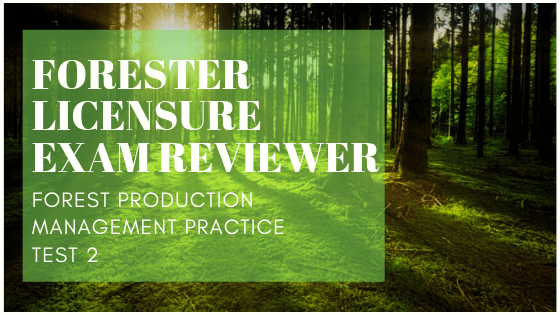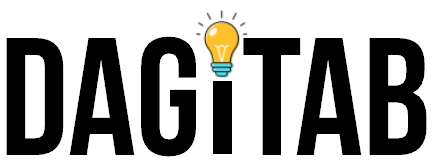
This Forestry Licensure Exam reviewer contains 50 questions related to the subject area: Forest Production and Management.
Instruction: Choose the best answer from the choices on each question by clicking on it. Immediately after choosing an answer, it will reveal if you’re correct or wrong. At the end of the test, it will also show how many items you got right including the percentage average.
-
Question of
A method of hewing branches of big trees with wide-spreading branches before felling operation to avoid or minimize damages to residuals
-
lopping off
-
bucking
-
skylining
-
pruning
-
-
Question of
Animal Unit Month (AUM) means the quantity of forage requirement of one (1) mature cow for a period of:
-
one month
-
one year
-
one day
-
one week
-
-
Question of
Soil structure, soil fertility, soil pH, and soil water and drainage are examples of what site factor?
-
edaphic
-
environmental
-
biotic
-
climatic
-
-
Question of
The classification of the lands of the public domain into alienable and disposal or forest lands is a responsibility of the Bureau of:
-
Lands
-
Soils
-
Fisheries
-
Forest Development
-
-
Question of
A cutting made to remove trees killed or badly injured to utilize sound materials before they become worthless
-
salvage cutting
-
selection cutting
-
coppicing
-
clearcutting
-
-
Question of
A balance between food, cover and animal population is a primary objective of:
-
wildlife management
-
watershed management
-
timber management
-
recreation management
-
-
Question of
Hunting and fishing activities have a direct impact on:
-
wildlife populations
-
water regimen
-
timber production
-
natural regeneration
-
-
Question of
Prices of timber were surveyed in a certain locality. The average free on board (FOB) market price of a certain group of timber was P1,275.00 per cu m. What was the corresponding forest charge?
-
P382.50/cu m
-
P191.25/cu m
-
P255.00/cu m
-
P318.75/cu m
-
-
Question of
Refers to small, fenced grazing lands that may have been improved by reseeding, fertilizing or irrigation
-
pasture
-
backyard garden
-
rangeland
-
sloping agricultural land
-
-
Question of
A watershed is said to be critical when it is:
-
in need of immediate reforestation
-
supporting a logging business
-
supporting a multipurpose dam and in need of reforestation
-
erosion is prevalent
-
-
Question of
The process of allocating land to specific use or combination of uses is called:
-
land-use planning
-
land use valuation
-
land evaluation
-
land capability
-
-
Question of
To bring about forest cover through artificial means to denuded areas with or without previous forest vegetation is referred to as:
-
reforestation
-
afforestation
-
deforestation
-
forestation
-
-
Question of
Timber in the natural forest are largely harvested and disposed of through:
-
stumpage sales
-
government licensing systems
-
public bidding
-
negotiated contracts
-
-
Question of
The money collected by the Bureau of Internal Revenue from loggers for timber cut from forest lands is called:
-
forest charges
-
reforestation fund
-
stumpage price
-
forest rent
-
-
Question of
The arrangement of natural streams on a watershed is referred to as:
-
drainage basin
-
drainage network
-
watershed discharge
-
aspect
-
-
Question of
Benefit-cost analysis involves consideration of:
-
benefit and cost of a project
-
alternative investment
-
return on investment
-
net present value
-
-
Question of
Ancestral lands refer to lands claimed by:
-
upland farmers
-
shifting cultivation
-
kaingineros
-
cultural communities
-
-
Question of
Aerial photos are very useful in:
-
timber inventories
-
land capability surveys
-
wildlife surveys
-
streamflow gauging
-
-
Question of
A measure of the degree of responsiveness of quantity demanded to price changes
-
deflation
-
elasticity
-
inflation
-
fluctuation
-
-
Question of
Drainage density of a watershed refers to:
-
stream quantity
-
sediment load
-
water volume
-
silt load
-
-
Question of
The larger and heavier sediments like sands and gravels that are sliding, rolling or bouncing along the bottom or bed of a stream is technically called:
-
bedrock
-
bedload
-
solid suspension
-
silt
-
-
Question of
Vertical exposure assembled by cutting, matching, and pasting together into a large photograph that appears as a single print is called:
-
photomosaic
-
aerial map
-
photographic map
-
aerial photo
-
-
Question of
A type of aerial photograph most adapted to forest inventories:
-
oblique photographs
-
vertical photographs
-
horizontal photographs
-
low oblique photographs
-
-
Question of
A photo scale is also referred to as:
-
representative fraction
-
parallax formula
-
natural scale
-
differential parallax
-
-
Question of
A community of trees possessing sufficient uniformity as regards composition, age and spatial arrangement:
-
forest stand
-
forest community
-
ecosystem
-
setup
-
-
Question of
Refers to the accumulated growth of trees in a stand:
-
yield
-
mortality
-
accretion
-
production
-
-
Question of
A tabular presentation that gives the volume of a standing tree given DBH, log length and species group is a:
-
volume table
-
stand and stock table
-
yield table
-
site index
-
-
Question of
In timber inventory “log” refers to:
-
a standing tree
-
the length of a standing tree
-
a felled tree
-
5-meter section of log
-
-
Question of
The dot-dash tally sheet is used in:
-
scaling felled logs
-
recording damaged residuals
-
tallying standing timber
-
computing volume of trees
-
-
Question of
The removal of undesirable species is a stand for the purpose of improving the quality of the desired trees is referred to as:
-
pruning
-
release cutting
-
timber stand improvement
-
selection cutting
-
-
Question of
This is an intermediate cut, the purpose of which is to provide more growing space to the preferred trees in the stand:
-
thinning
-
sanitation cutting
-
pruning
-
release cutting
-
-
Question of
Slope is a basic consideration in land classification. As a rule, the maximum gradient allowable for alienable and disposable lands is:
-
17 percent
-
10 percent
-
19 percent
-
15 percent
-
-
Question of
Land-use planning involves:
-
land-use allocation
-
land capability evaluation
-
land suitability classification
-
all of the choices
-
-
Question of
Government regulations provide that the maximum gradient of lands allowed for grazing is:
-
18 percent
-
20 percent
-
49 percent
-
40 percent
-
-
Question of
The diameter of a tree with a circumference of 226.2 cm
-
72
-
47
-
88
-
69
-
-
Question of
The objective/s of establishing buffer zones between production forests and areas used for agricultural and other purposes is/are: (1) to serve as protective belt on the exposed natural forest from encroachment and destruction; and (2) to provide livelihood opportunities to rural communities.
-
Only objective 2 is correct
-
Only objective 1 is correct
-
Both objectives are incorrect
-
Both objectives mentioned are correct
-
-
Question of
A poisonous weed common in pasture lands is hagonoy or “bungargar”. It’s scientific name is:
-
Paspalum sp.
-
Amorpopalus campanulatus
-
Chromolaena odorata
-
Agathis alba
-
-
Question of
Stewardship certificates are long-term forest occupancy permits issued by the [BFD], under its:
-
Integrated Social Forestry Program
-
Range Management Program
-
Forestation program
-
PROFEM
-
-
Question of
The volume of timber a licensee is allowed to cut inside his timber concession per year is called:
-
annual allowable cut
-
annual field
-
annual log export quota
-
annual increment
-
-
Question of
One of the following is not a measure of determining the financial or economic value of forest land and/or forest resources
-
Benefit-cost ratio
-
Consumer index
-
Internal rate of return
-
Net present value
-
-
Question of
Approaches to allowable cut determination are classified generally into area control and …
-
marking goal
-
marking goal
-
volume control
-
number of trees
-
-
Question of
The amount by which one photograph includes the same area covered by another, customarily expressed as a percentage –
-
parallax
-
photographic lapse
-
overlay
-
overlap
-
-
Question of
A method used for wildlife inventory that makes use of a devise in order to live capture and take a certain animal species –
-
quadrat method
-
rapid visual survey
-
trapping
-
shooting
-
-
Question of
A grazing method where livestock are stalled separately from the grazing area and herbage is cut and carried to the animals for feeding
-
continuous grazing
-
zero grazing
-
rotational grazing
-
none of the choices
-
-
Question of
An instrument used for determining elevation
-
altimeter
-
caliper
-
abney hand level
-
clinometer
-
-
Question of
If the distance between two objects on a photograph is 1 centimeter and on a map with a scale of 1:20,000 the same objects are one-half centimeter apart, the scale of the photograph is:
-
1/10,000
-
1/20,000
-
1/5,000
-
1/15,000
-
-
Question of
Volume control means regulating timber cutting by specifying:
-
the species to cut
-
the sizes of trees to be cut
-
the volume that shall be cut
-
the area where cutting is done
-
-
Question of
Timber stand improvement (TSI) involves the:
-
cutting of vines, defective trees and weeds
-
enrichment planting
-
marking of trees to be left after logging
-
prescribed burning
-
-
Question of
The purpose of TSI is to:
-
improve site quality
-
produce high-quality
-
improve water yield
-
prevent the incidence of pest
-
-
Question of
The selective logging system specifies that healthy residuals should be:
-
distributed around the spar tree
-
located along cableways
-
concentrated around the spar tree
-
concentrated along the setup boundary
-
